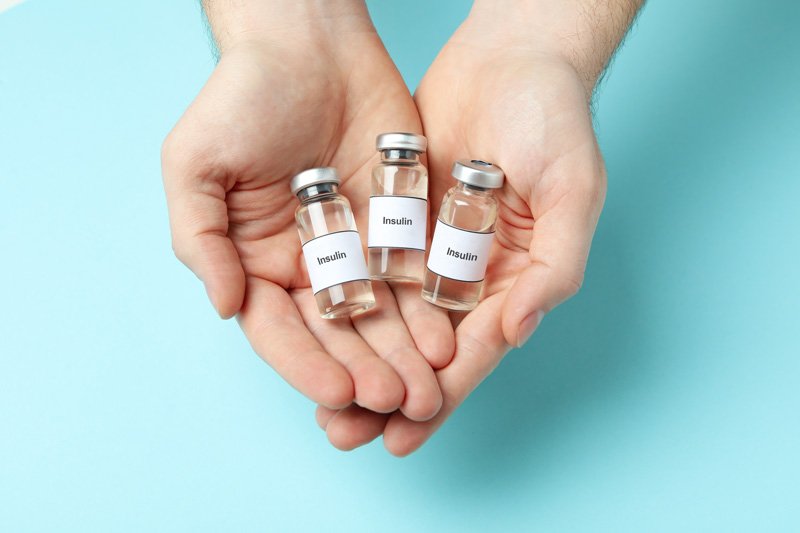Type 2 diabetes can be a challenging journey, requiring careful management and informed decision-making. As the condition progresses, many individuals consider or incorporate insulin medication into their treatment plan. This blog aims to provide a thorough understanding of insulin medication for Type 2 diabetes, offering valuable insights, practical tips, and empowering knowledge to help you make informed choices for your health.
Contents
When Is Insulin Medication For Type 2 Diabetes Recommended?
 Insulin medication for Type 2 diabetes is typically recommended in specific situations where other treatment options, such as oral medications and lifestyle modifications, may no longer be sufficient to control blood sugar levels. Here are common scenarios when insulin therapy might be considered:
Insulin medication for Type 2 diabetes is typically recommended in specific situations where other treatment options, such as oral medications and lifestyle modifications, may no longer be sufficient to control blood sugar levels. Here are common scenarios when insulin therapy might be considered:
- Inadequate Blood Sugar Control with Oral Medications: If blood glucose levels remain elevated despite the use of oral medications, your healthcare provider may suggest adding insulin to your treatment plan.
- Progressive Nature of Type 2 Diabetes: Over time, the pancreas in individuals with Type 2 diabetes may produce less insulin. The need for supplemental insulin to maintain optimal blood sugar control may increase as the disease progresses.
- During Acute Illness or Surgery: Illness, surgery, or other medical conditions can cause fluctuations in blood sugar levels. In such situations, temporary insulin use may be recommended to manage elevated glucose levels and promote a faster recovery.
- Pregnancy (Gestational Diabetes): Women with gestational diabetes may require insulin therapy if blood sugar levels cannot be effectively controlled through diet and lifestyle changes alone. Insulin is considered safe during pregnancy and is often used to protect the health of both the mother and the baby.
- Severe Insulin Resistance: Some individuals with Type 2 diabetes may develop insulin resistance, where the body’s cells do not respond effectively to insulin. In such cases, higher insulin doses or more intensive insulin regimens may be necessary.
It’s important to note that the decision to start insulin therapy is highly individualized. Healthcare providers carefully assess each person’s unique circumstances and tailor treatment plans to meet their needs.
What Are The Best Insulin Medications for Type 2 Diabetes?
The choice of insulin medication for Type 2 diabetes depends on various factors, including the individual’s specific needs, lifestyle, and health status. Healthcare providers carefully consider these factors when prescribing insulin to ensure effective blood sugar control. Here are some common types of insulin used for Type 2 diabetes:
Rapid-Acting Insulin
Rapid-acting insulins, such as insulin lispro (Humalog), insulin aspart (NovoLog), and insulin glulisine (Apidra), are designed to act quickly after injection. They have an onset of around 15 minutes, which makes them suitable for managing postprandial (after-meal) glucose spikes. These insulins peak within 1-2 hours, aligning with the digestion and absorption of a meal. Patients typically inject rapid-acting insulin just before or immediately after meals to help regulate blood sugar levels effectively during the critical post-meal period.
Short-Acting Insulin
Regular insulin (Humulin R, Novolin R) is a short-acting insulin that takes about 30 minutes to start working and peaks in 2-3 hours. It is commonly used before meals to help control blood sugar levels during the mealtime period. Regular insulin provides a more prolonged effect compared to rapid-acting insulins. And, making it suitable for managing blood sugar levels over a slightly longer duration.
Intermediate-Acting Insulin
NPH insulin (Humulin N, Novolin N) is an intermediate-acting insulin with a slower onset and an extended duration of action. It typically peaks between 4-8 hours after injection, making it suitable for maintaining blood sugar levels between meals and overnight. NPH insulin is often used as part of a twice-daily injection regimen to provide basal insulin coverage.
Long-Acting Insulin
Long-acting insulins, such as insulin glargine (Lantus, Basaglar), insulin detemir (Levemir), and insulin degludec (Tresiba), provide a steady release of insulin over an extended period. These insulins are designed to offer a baseline level of insulin that lasts approximately 24 hours. Long-acting insulins are typically taken once daily and help provide a continuous and stable level of insulin throughout the day and night. This helps to manage fasting blood sugar levels and provides a foundation for more targeted mealtime insulin.
Premixed Insulin
Premixed insulins combine short- or rapid-acting insulin with intermediate-acting insulin in a single formulation. These insulins provide both immediate and longer-term insulin coverage and are typically taken before meals. The premixed insulin ratio is designed to address the patient’s specific insulin needs throughout the day. It offers convenience for individuals who prefer a simpler insulin regimen by combining multiple types of insulin into a single injection.
It’s essential to note that the choice of insulin regimen is highly individualized. Thus, healthcare providers may recommend different combinations or adjustments based on the patient’s response and needs. Additionally, advancements in insulin therapy continue to evolve, with new formulations and delivery methods being developed.
What Are The Side Effects Of Insulin Medication For Type 2 Diabetes?
 Insulin is a crucial and effective medication for managing blood sugar levels in individuals with Type 2 diabetes. While insulin is generally safe and well-tolerated, like any medication, it can have potential side effects. Here are some common side effects associated with insulin medication for Type 2 diabetes:
Insulin is a crucial and effective medication for managing blood sugar levels in individuals with Type 2 diabetes. While insulin is generally safe and well-tolerated, like any medication, it can have potential side effects. Here are some common side effects associated with insulin medication for Type 2 diabetes:
Hypoglycemia (Low Blood Sugar)
Hypoglycemia is a common side effect of insulin therapy. It can occur if the insulin dosage is too high or if there is a mismatch between insulin and food intake. Symptoms of hypoglycemia include shakiness, sweating, dizziness, confusion, and, in severe cases, unconsciousness. Prompt treatment with glucose or fast-acting carbohydrates is necessary to raise blood sugar levels.
Weight Gain
Some individuals may experience weight gain with insulin therapy. This can be attributed to improved glucose control, leading to increased energy storage. It’s important to maintain a balanced diet and incorporate regular physical activity to manage weight effectively.
Injection Site Reactions
Redness, swelling, or irritation at the injection site can occur. Rotating injection sites and using proper injection techniques can help minimize these reactions. In rare cases, lipodystrophy (changes in fat tissue) may develop at injection sites, leading to lumps or dents.
Allergic Reactions
While rare, some individuals may be allergic to components of insulin formulations. Signs of an allergic reaction include skin rash, itching, shortness of breath, or swelling. Seek medical attention promptly if any allergic reactions occur.
Insulin Resistance
Prolonged use of insulin may, in some cases, lead to insulin resistance, where the body’s cells become less responsive to insulin. This can necessitate adjustments to the insulin regimen or changes in overall diabetes management.
Fluid Retention
Insulin can sometimes lead to fluid retention, causing swelling in the hands, feet, or ankles. Individuals with heart or kidney conditions may be more susceptible to this side effect.
Lipohypertrophy
Lipohypertrophy is the thickening or lump formation under the skin at injection sites. It can affect insulin absorption and should be avoided by rotating injection sites and using proper injection techniques.
Vision Changes
Temporary changes in vision, such as blurriness, may occur, especially when starting insulin therapy. These changes are usually transient, and vision typically stabilizes with continued use.
It’s crucial to communicate openly with your healthcare provider about any side effects or concerns related to insulin therapy. They can adjust your insulin regimen, provide guidance on minimizing side effects, and address any questions you may have.
What Are Some Combination Treatments You Can Choose?
 Combination treatments for Type 2 diabetes involve using multiple medications with different mechanisms of action to achieve better blood sugar control. Here are some common combination treatments for Type 2 diabetes:
Combination treatments for Type 2 diabetes involve using multiple medications with different mechanisms of action to achieve better blood sugar control. Here are some common combination treatments for Type 2 diabetes:
Metformin + Sulfonylureas
Metformin is often prescribed as the first-line oral medication for Type 2 diabetes. It works by reducing glucose production in the liver. Sulfonylureas, such as glipizide or glimepiride, stimulate the pancreas to release more insulin. Combining metformin with sulfonylurea can enhance the overall effectiveness of blood sugar control.
Metformin + DPP-4 Inhibitors
Dipeptidyl peptidase-4 (DPP-4) inhibitors, like sitagliptin or saxagliptin, work by increasing the levels of incretin hormones, which stimulate insulin release and reduce glucagon production. Combining metformin with a DPP-4 inhibitor provides a complementary approach to improve glucose regulation.
Metformin + SGLT2 Inhibitors
Sodium-glucose cotransporter-2 (SGLT2) inhibitors, such as empagliflozin or canagliflozin, reduce glucose reabsorption in the kidneys, leading to increased urinary excretion of glucose. Combining metformin with an SGLT2 inhibitor addresses glucose control through different mechanisms and may provide added benefits.
Metformin + GLP-1 Receptor Agonists
Glucagon-like peptide-1 (GLP-1) receptor agonists, like liraglutide or dulaglutide, stimulate insulin release and reduce glucagon production. They also slow down gastric emptying, leading to improved postprandial glucose control. Combining metformin with a GLP-1 receptor agonist offers a dual approach to managing blood sugar levels.
Sulfonylureas + DPP-4 Inhibitors
Combining sulfonylurea with a DPP-4 inhibitor provides a synergistic effect by stimulating insulin release and reducing glucagon production through different mechanisms. This combination may be considered when blood sugar control is not adequately achieved with a single medication.
Insulin + Metformin or Other Oral Medications
In some cases, healthcare providers may prescribe insulin in combination with oral medications, such as metformin or sulfonylureas. This approach allows for a more tailored and flexible treatment plan, addressing both basal and mealtime insulin needs.
Triple Therapy (Metformin + SGLT2 Inhibitor + DPP-4 Inhibitor)
In certain situations, a combination of metformin, an SGLT2 inhibitor, and a DPP-4 inhibitor may be prescribed to address multiple aspects of glucose regulation. This triple therapy is considered for individuals requiring intensive management of Type 2 diabetes.
It’s essential to note that the choice of combination therapy is highly individualized. Healthcare providers consider factors such as the patient’s overall health, specific needs, potential side effects, and preferences when determining the most appropriate combination of medications.
Conclusion
In conclusion, insulin medication for Type 2 diabetes involves a personalized journey as part of a comprehensive treatment plan. Understanding the different types of insulin, their potential side effects, and when they are recommended is crucial for making informed decisions about your health. Whether you’re exploring insulin for the first time or considering a combination of medications, the key is open communication with your healthcare team.
Remember, with the right knowledge, support, and a proactive approach to self-care, individuals with Type 2 diabetes can navigate their journey successfully. And, achieving optimal blood sugar control and leading a healthy, fulfilling life.
Do you want to get rid of diabetes? Join our online diabetes treatment program and reverse Diabetes naturally through lifestyle changes such as a Personalized Diet plan, Exercise, Yoga, dieticians, and health coaches.

